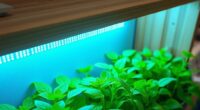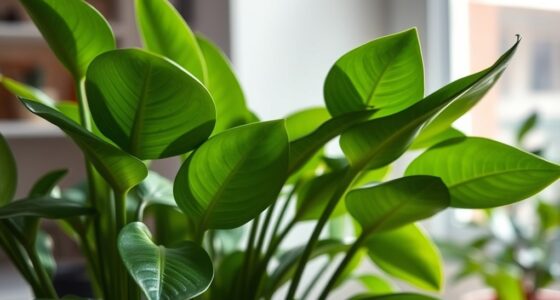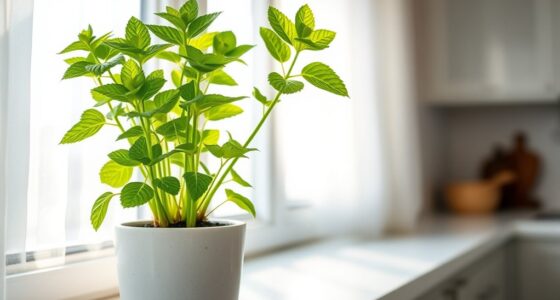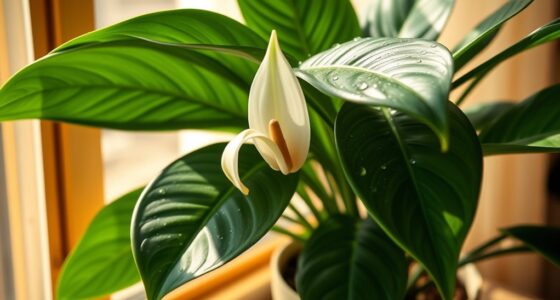Caring for your spider plant is simple: provide bright, indirect light and maintain temperatures between 65°F and 75°F. Water when the top inch of soil feels dry, and use well-draining soil to prevent sogginess. Fertilize lightly during spring and summer, and reduce feeding during colder months. To propagate, root spiderettes in water or soil, and with proper care, you’ll grow a lush, air-purifying plant in no time. Keep exploring to master all the tips!
Key Takeaways
- Provide bright, indirect light and maintain temperatures between 65°F-75°F for healthy growth.
- Water only when the top 1-2 inches of soil are dry, avoiding overwatering and sogginess.
- Fertilize monthly in spring and summer with diluted balanced fertilizer; reduce in fall/winter.
- Propagate spiderettes by rooting them in water or soil with proper light and moisture.
- Regularly inspect for pests and maintain good airflow to keep your spider plant healthy and thriving.
Understanding the Benefits of Spider Plants
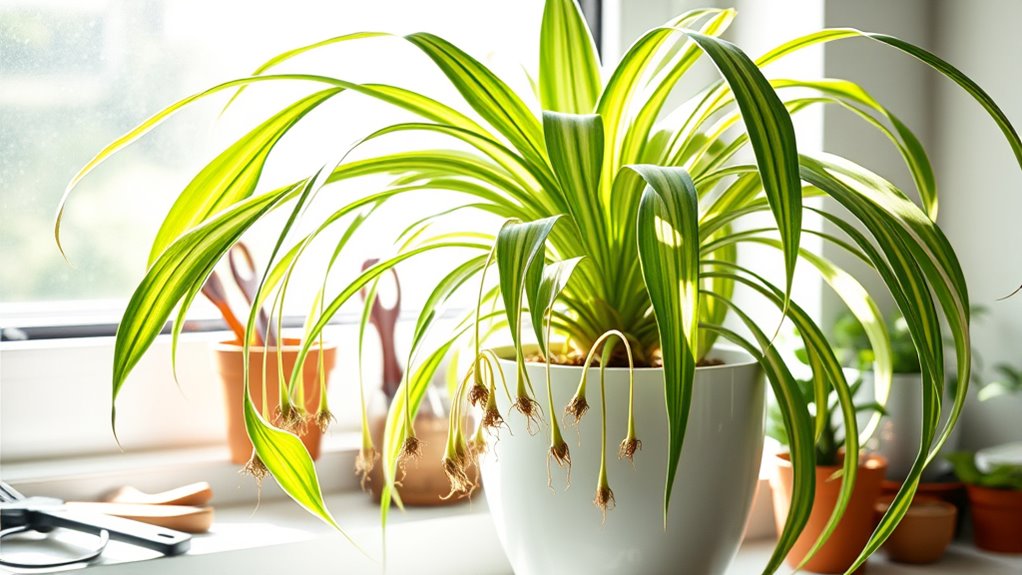
Spider plants are highly valued for their ability to improve indoor air quality while adding natural beauty to your space. As popular indoor plants, they effectively remove toxins like formaldehyde and benzene, making your environment healthier.
Their long, cascading leaves and small white flowers enhance any home or office decor with natural elegance. These plants are low maintenance, tolerating varying light and water conditions, which makes plant care simple for beginners. Additionally, their resilience and air-purifying qualities make them a smart choice for boosting both health and aesthetics indoors. Studies show that air-purifying qualities can significantly improve indoor air quality and contribute to better health. Spider plants also produce numerous spiderettes—small offsets that you can easily propagate to grow your indoor garden. Their ability to withstand varying light conditions makes them especially suitable for diverse indoor environments. Using proper watering techniques can help ensure their healthy growth and longevity. Proper lighting conditions are also essential for optimal growth. Incorporating spider plants into your space brings the benefits of cleaner air and effortless beauty.
Optimal Lighting and Temperature Conditions
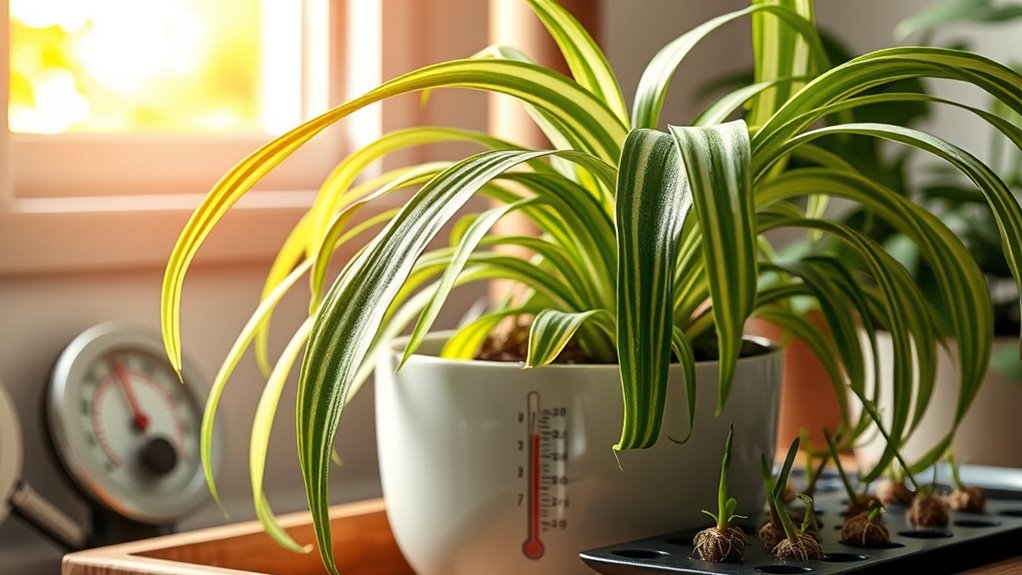
To keep your spider plant healthy and vibrant, providing the right lighting and temperature conditions is essential. Guarantee it receives bright, indirect sunlight—about 12-14 hours daily—by placing it near east or west windows. Avoid direct sunlight, which can scorch leaves and cause brown tips.
Ensure your spider plant gets bright, indirect sunlight for 12-14 hours daily, avoiding direct rays to prevent leaf scorch and brown tips.
Maintain room temperatures between 65°F and 75°F (18°C to 24°C); lower temperatures below 55°F can stress the plant.
Here are key tips:
- Use well-draining soil to prevent root rot.
- Adjust watering frequency based on light; less water in lower light.
- Protect plant roots from temperature fluctuations and drafts.
- Keep lighting consistent to promote healthy growth and minimize brown tips.
Proper Watering and Soil Requirements
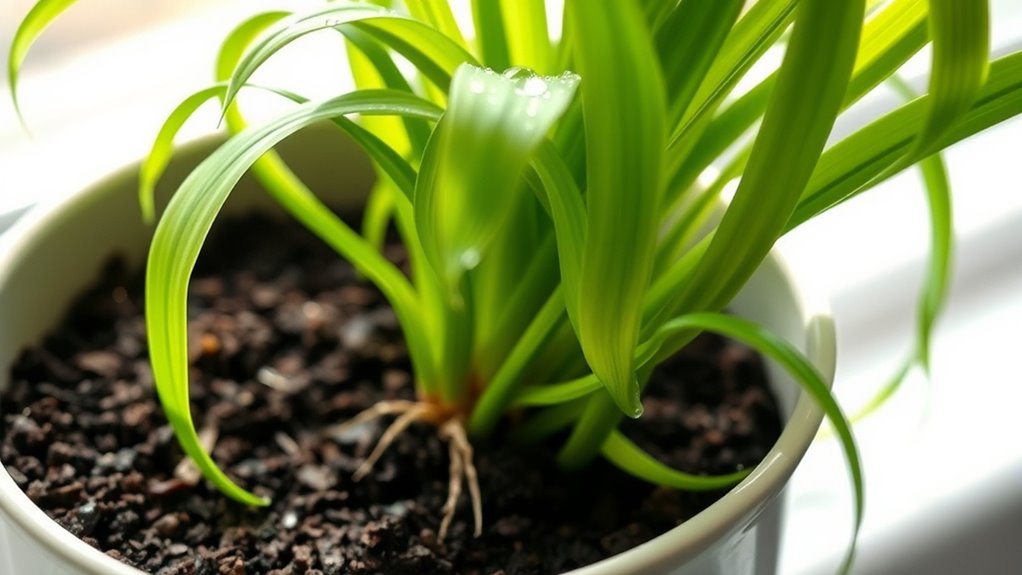
To keep your spider plant healthy, you need to pay attention to soil drainage and watering habits. Use a well-draining, loamy mix and make sure the pot has drainage holes to prevent water from sitting. Proper watering ensures the roots don’t become waterlogged and develop root issues, which can harm the plant’s overall health. Check the top inch or two of soil regularly and water only when it’s dry to avoid overwatering or root issues. Additionally, selecting a filtration technology that suits your space can help maintain optimal air quality, supporting your plant’s environment. Ensuring good air circulation can further prevent soil compaction, promoting healthier root development. Incorporating knowledge of automation in business can inspire innovative ways to optimize your plant care routine, such as using automated watering systems.
Soil Drainage Importance
Ensuring proper soil drainage is essential for healthy spider plant growth, as it prevents excess water from pooling around the roots. Poor drainage can lead to root rot and other fungal issues. Using a well-draining potting mix with perlite or sand to enhance drainage. Choose containers with drainage holes to allow excess water to escape. Avoid heavy, clay-based soils that retain moisture too long. Regularly check soil moisture levels to prevent overwatering. Incorporating water conservation techniques can also help maintain optimal moisture levels and promote healthy root development. Additionally, incorporating proper watering practices ensures that plants receive the right amount of moisture without excess, supporting overall plant health. Selecting self watering plant pots can significantly reduce watering frequency and help maintain consistent soil moisture levels. Proper soil drainage is especially important for preventing overwatering, which is a common cause of spider plant problems.
Watering Frequency Tips
Watering your spider plant at the right frequency is key to keeping it healthy. You should water your spider only when the soil dries out to about 1-2 inches deep, preventing overwatering and root rot. Water your plant thoroughly, ensuring excess water drains away through the pot’s holes.
During spring and summer, water frequently—about once a week—adjusting based on indoor humidity and temperature. In fall and winter, reduce watering to let the soil dry more between waterings, avoiding excess moisture that can cause fungal issues.
Always use room temperature, dechlorinated water to protect the roots. Good water management involves monitoring soil moisture and avoiding waterlogging.
Moisture Level Monitoring
Monitoring soil moisture is key to maintaining your spider plant’s health and avoiding common issues like overwatering or underwatering. To do this effectively, you should:
- Check soil moisture regularly by inserting your finger 1-2 inches into the soil or using a moisture meter.
- Keep soil slightly moist during active growth, avoiding sogginess that can lead to waterlogged roots.
- Use well-draining soil and pots with drainage holes to prevent excess water buildup.
- Adjust watering frequency seasonally, watering less during winter when growth slows and soil dries out more easily.
Consistently monitoring soil moisture helps you maintain ideal hydration, ensuring your plant stays healthy without the risk of root rot or dehydration. Proper watering is essential for preventing issues and promoting robust growth.
Fertilizing and Seasonal Care Tips

To keep your spider plant thriving, it’s important to adjust fertilizing routines with the seasons. During spring and summer, feed it once or twice a month with a diluted balanced fertilizer. But cut back in fall and winter when growth slows. Using slow-release fertilizers can help provide consistent nutrients and reduce the need for frequent feeding. Being aware of legislative changes related to plant care and gardening regulations can also help ensure you stay compliant with local laws. Staying informed about best gardening practices can further enhance your plant care routine. Additionally, understanding sustainable gardening techniques can promote healthier growth and environmental benefits. Regularly inspecting your plant for pests and diseases aligns with wood stove safety principles by maintaining a safe and healthy environment for your plants. Incorporating proper fertilization strategies can also support the overall health and longevity of your spider plant.
Seasonal Fertilizer Schedule
During the active growing seasons of spring and summer, fertilize your spider plant once a month with a diluted, balanced houseplant fertilizer to promote healthy foliage and abundant spiderettes. This fertilizer schedule guarantees steady, healthy growth.
As fall and winter approach, reduce or stop fertilizing altogether, since the plant’s growth naturally slows.
To maximize nutrient absorption and prevent root burn, always apply fertilizer after watering. Use a liquid fertilizer at half the recommended strength for best results.
Keep these tips in mind:
- Fertilize monthly during spring and summer.
- Use a diluted, houseplant fertilizer or liquid fertilizer.
- Reduce or halt feeding in fall and winter.
- Always water before applying fertilizer for healthy growth.
Adjusting Nutrients Year-Round
Adjusting your spider plant’s nutrients throughout the year guarantees it stays healthy and vibrant. During spring and summer, fertilize once a month with a diluted, balanced houseplant fertilizer to support vigorous growth. In fall and winter, reduce or stop fertilizing as the plant enters dormancy and growth slows down. Always apply fertilizer when the soil is slightly moist to prevent root burn and enhance nutrient absorption. Use a liquid fertilizer at half strength to avoid overfeeding and leaf burn. Adjust your fertilization schedule based on the plant’s growth rate and health, increasing feeding during active periods. Visualize this schedule:
| Season | Fertilizer Frequency | Nutrients Focus |
|---|---|---|
| Spring | Monthly | Growth |
| Summer | Monthly | Vigorous nutrients |
| Fall | Reduce or stop | Dormancy |
| Winter | No fertilizing | Rest period |
| Year-round | Adjust as needed | Nutrient absorption |
Additionally, ensuring proper filtration and pump protection can help maintain optimal nutrient delivery and overall plant health. Proper watering practices and soil quality also play a crucial role in nutrient uptake, supporting the plant’s overall well-being. Regular monitoring of plant health and adjusting fertilization accordingly can help prevent deficiencies and promote sustained vitality. Maintaining consistent fertilizer application based on seasonality can further optimize your plant’s growth and vitality.
Common Pests and Disease Prevention
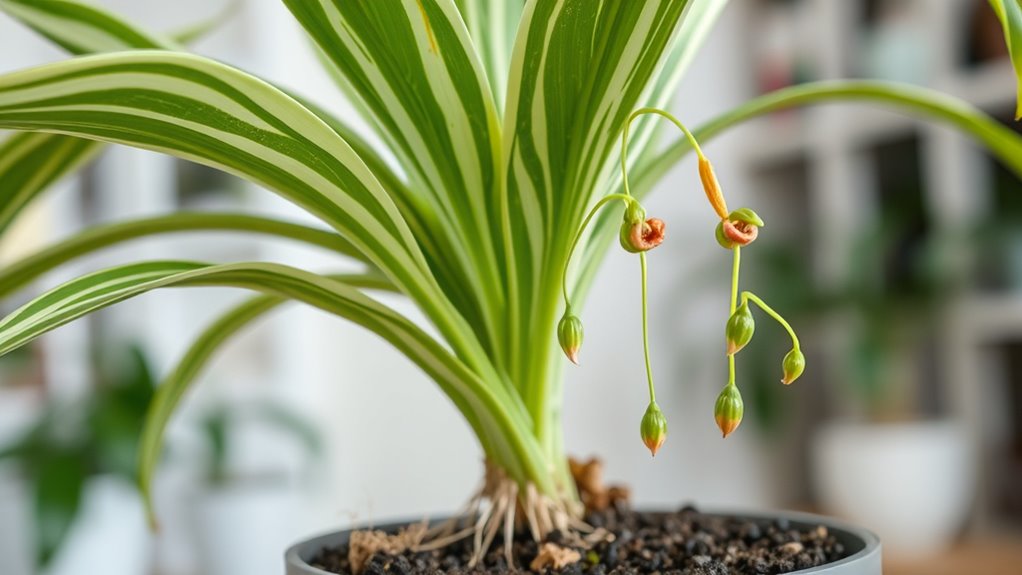
Spider plants are naturally resistant to pests, but they can still attract spider mites, aphids, or mealybugs if they become stressed or are overwatered. To guarantee pest prevention and maintain plant health, regularly inspect your plant’s leaves and stems for early signs of infestation.
Follow these steps:
Follow these steps for pest prevention and healthy spider plants.
- Practice proper watering and ensure good drainage to prevent fungal diseases like root rot.
- Maintain ideal environmental conditions—adequate light, humidity, and airflow—to reduce pests and disease risk.
- Use organic pest control methods, such as neem oil or insecticidal soap, for safe, effective treatment.
- Keep your plant healthy through consistent care, which helps bolster disease control and keeps pests at bay.
Regularly monitoring your spider plant is key to keeping it thriving.
Methods for Propagating Spider Plants

Propagating spider plants is a straightforward process that allows you to expand your indoor garden easily.
You can propagate spider plants by detaching and rooting their spider plant babies, which develop tiny roots on long stems. To do this, carefully snip off the spiderettes with sterilized scissors or knives to prevent disease.
You can root these babies directly in soil or place them in water until roots are established, usually taking 1-2 weeks.
Larger spider plants can also be propagated through division by separating sections with roots and leaves from the main plant.
Additionally, stolons—runners with baby plants—can be placed into soil while still attached to the mother plant until they take root.
These propagation methods make growing new spider plants simple and rewarding.
Step-by-Step Guide to Rooting in Water
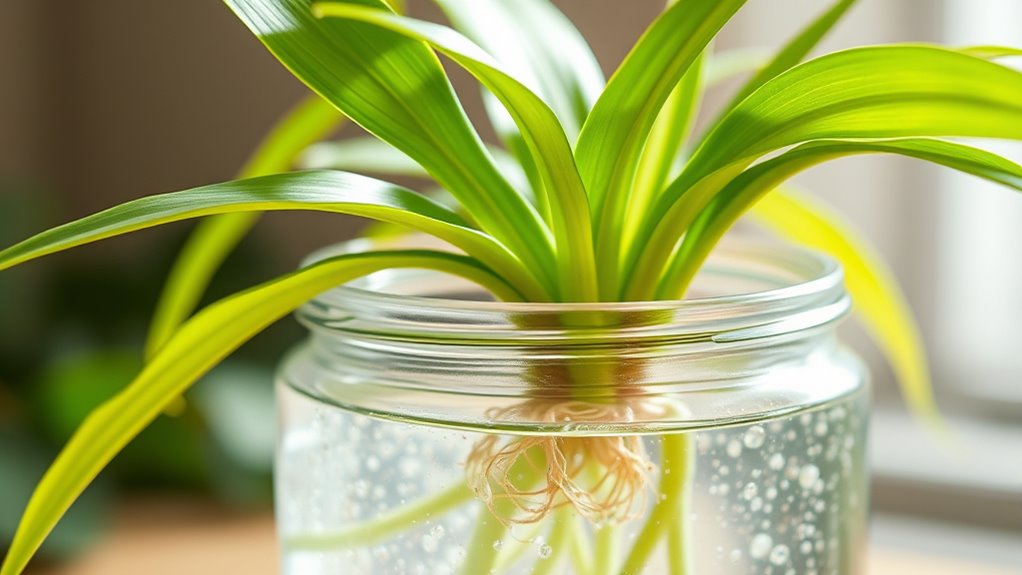
Rooting your spider plant in water is a simple and effective way to propagate new plants. First, select a healthy spiderette, leaving at least a few inches of stolon with tiny roots if available.
Then, follow these steps:
- Place the stem in a clear glass or jar filled with room-temperature, dechlorinated water, keeping leaves above the waterline.
- Position the glass in bright, indirect sunlight to encourage root growth without sunburn.
- Maintain a consistent water level and change it weekly to prevent stagnation.
- Wait about 7-10 days for roots to develop 2-3 inches long before transferring the baby plants into well-draining soil for continued growth.
This propagation method guarantees healthy root development and successful water propagation of your spiderette.
How to Grow Healthy Spider Plant Babies
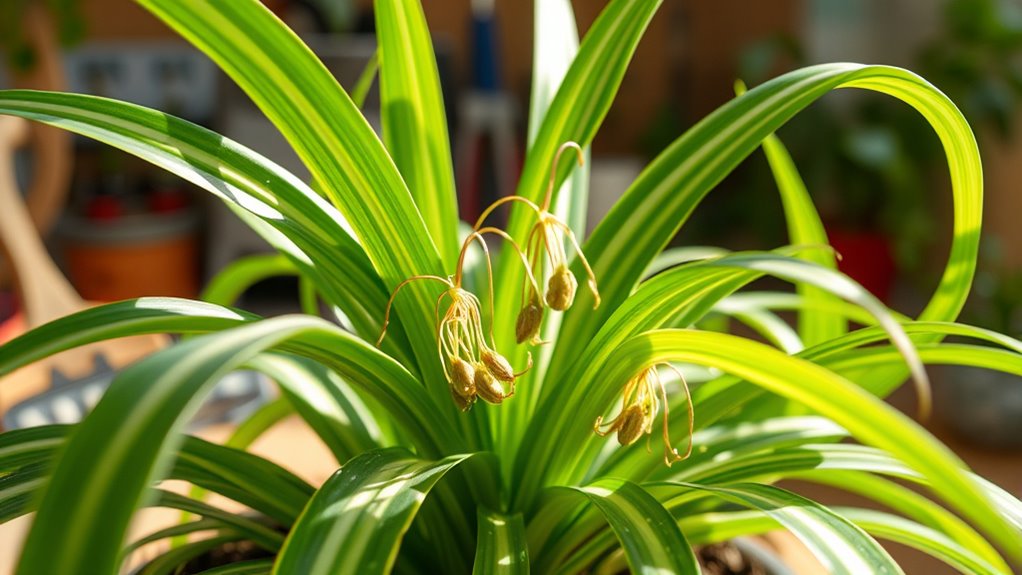
Once your spiderette has developed small roots or shows signs of growth, gently remove it from the mother plant to guarantee healthy establishment.
To propagate your spider plant babies effectively, plant them in well-draining, lightweight soil with adequate moisture. Use a pot with drainage holes to prevent overwatering, which can lead to root rot.
Place the container in a bright, indoor spot with indirect light, ensuring consistent warmth and humidity. Keep the soil slightly moist, watering only when the top feels dry.
Roots typically establish within a few weeks, which you can check by gently tugging—resistance indicates healthy rooting.
For faster growth, you can root spiderettes in water first, then transfer them to soil once roots reach 2-3 inches.
Tips for Maintaining a Full and Vibrant Plant

To keep your spider plant looking full and vibrant, regular maintenance is essential. Here are key tips to achieve that:
- Prune faded or damaged leaves to promote a fuller, healthier appearance.
- Water consistently and fertilize during the growing season to support vigorous growth.
- Provide bright, indirect light to enhance foliage fullness and vibrancy.
- Repot or divide the plant every 2-3 years to prevent overcrowding and maintain a lush shape.
Additionally, planting multiple spiderettes together encourages dense, bushy growth. Regularly dividing the plant keeps it healthy and full.
These simple steps ensure your spider plant remains vibrant, lush, and thriving. Proper pruning, watering, fertilization, light, repotting, and dividing are your best tools for a lively, beautiful plant.
Frequently Asked Questions
What Is the Easiest Way to Propagate a Spider Plant?
The easiest way to propagate a spider plant is by snipping off the spiderettes, or baby plants, and rooting them directly in soil or water.
You’ll notice tiny roots forming while hanging on the mother plant, making detachment simple. If you prefer, you can root them in water first to watch root growth, then transplant.
Planting multiple spiderettes together helps create a fuller look with minimal effort.
Should I Cut the Babies off My Spider Plant?
Deciding whether to detach or delay depends on your desire to propagate or preserve.
If you want new plants, gently grasp the baby and snip it with sterilized scissors once roots are tiny or about 4-6 inches long.
If tidiness trumps, trimming the tendrils keeps your plant tidy and thriving.
Regular removal prevents overcrowding, encouraging a fuller, bushier beauty, making your spider plant healthier and happier.
Is It Better to Propagate Spider Plants in Water or Soil?
When choosing between water and soil propagation, consider your priorities. Water propagation lets you easily watch root growth and keeps things cleaner, which is great if you’re a beginner.
Soil propagation often results in faster growth and a more natural shift for the plant. If you prefer simplicity and observation, go with water.
But if speed and stronger roots matter more, planting directly in soil is your best bet.
Should I Cut the Brown Tips off My Spider Plant?
Imagine your spider plant’s leaves as graceful green ribbons, now marred by brown tips. You should trim these brown edges to boost its appearance and prevent pests from settling in. However, remember, snipping only addresses the surface.
To truly help your plant thrive, check your watering habits, reduce fertilizer buildup, and increase humidity. That way, your plant’s vibrant beauty can flourish, free of those unsightly tips.
Conclusion
With just a little love and attention, your spider plant can grow into a lush, jungle-like wonderland that would make even the most exotic rainforest jealous. Watch as the vibrant green leaves cascade like a waterfall, sprouting dozens of tiny plant babies ready to transform every corner of your home into a lush, green paradise. With proper care, you’ll turn your space into a breathtaking oasis so alive and vibrant, it’ll feel like your plants are dancing with joy!

